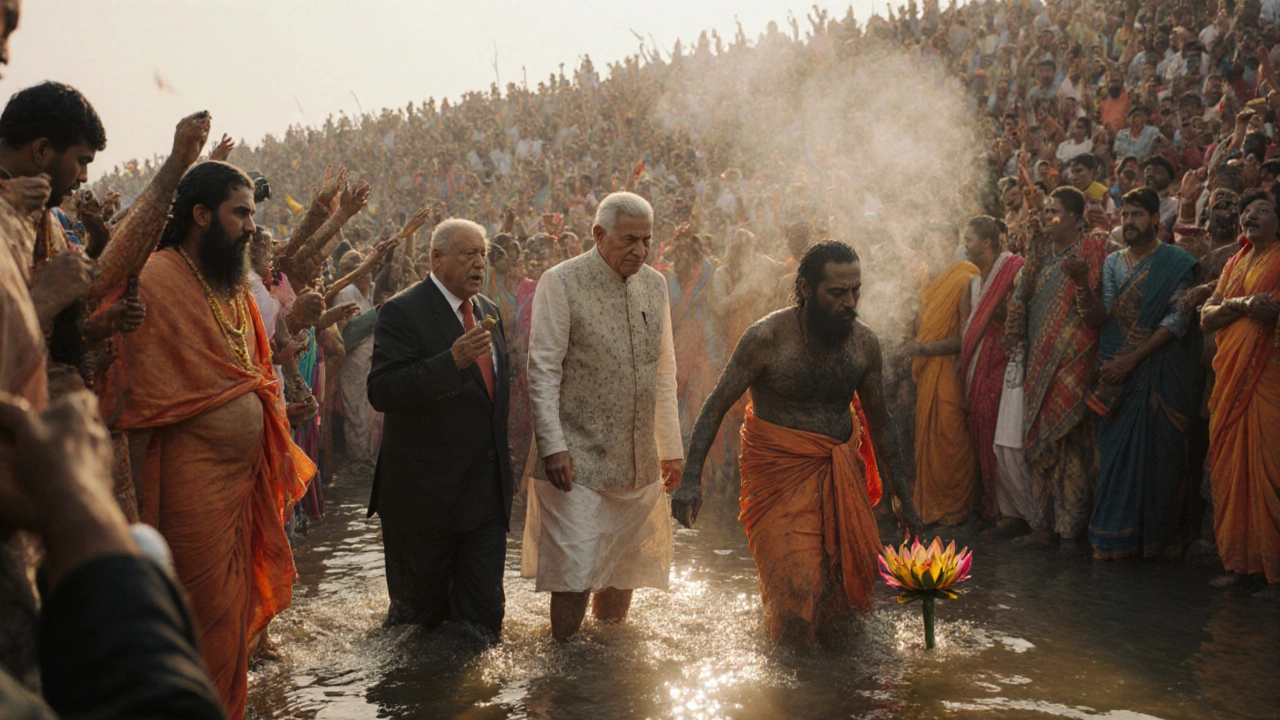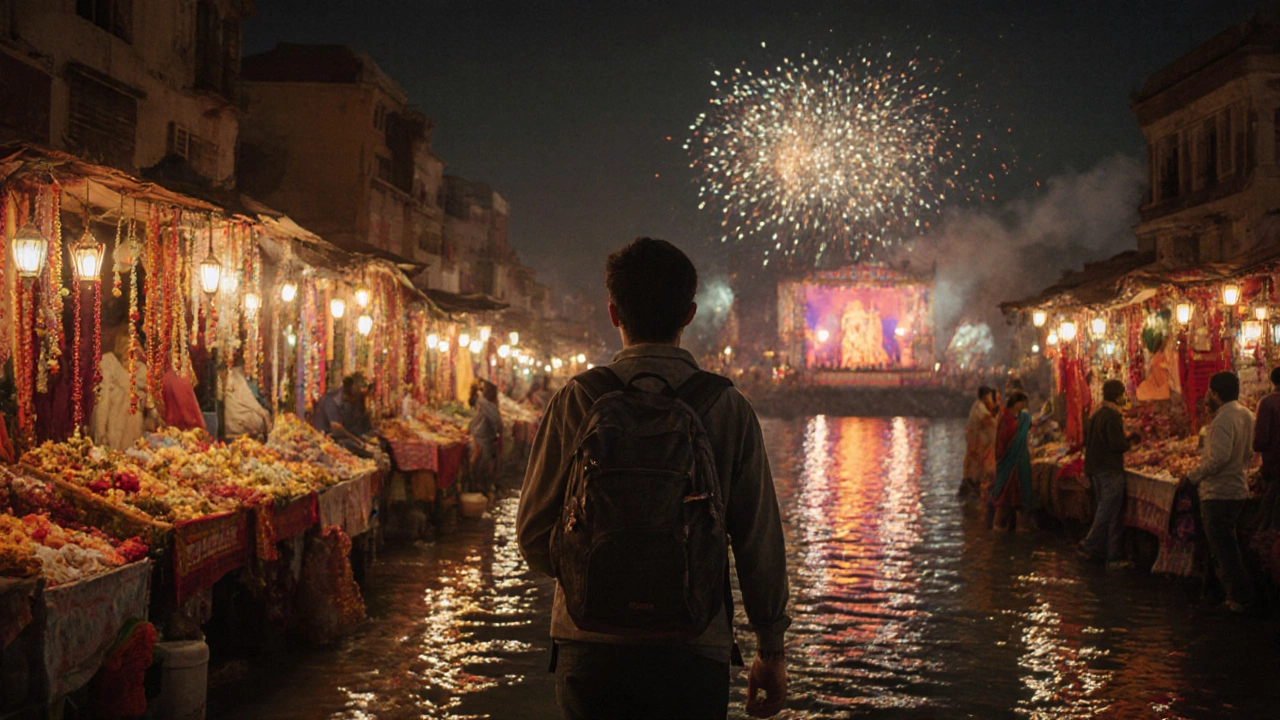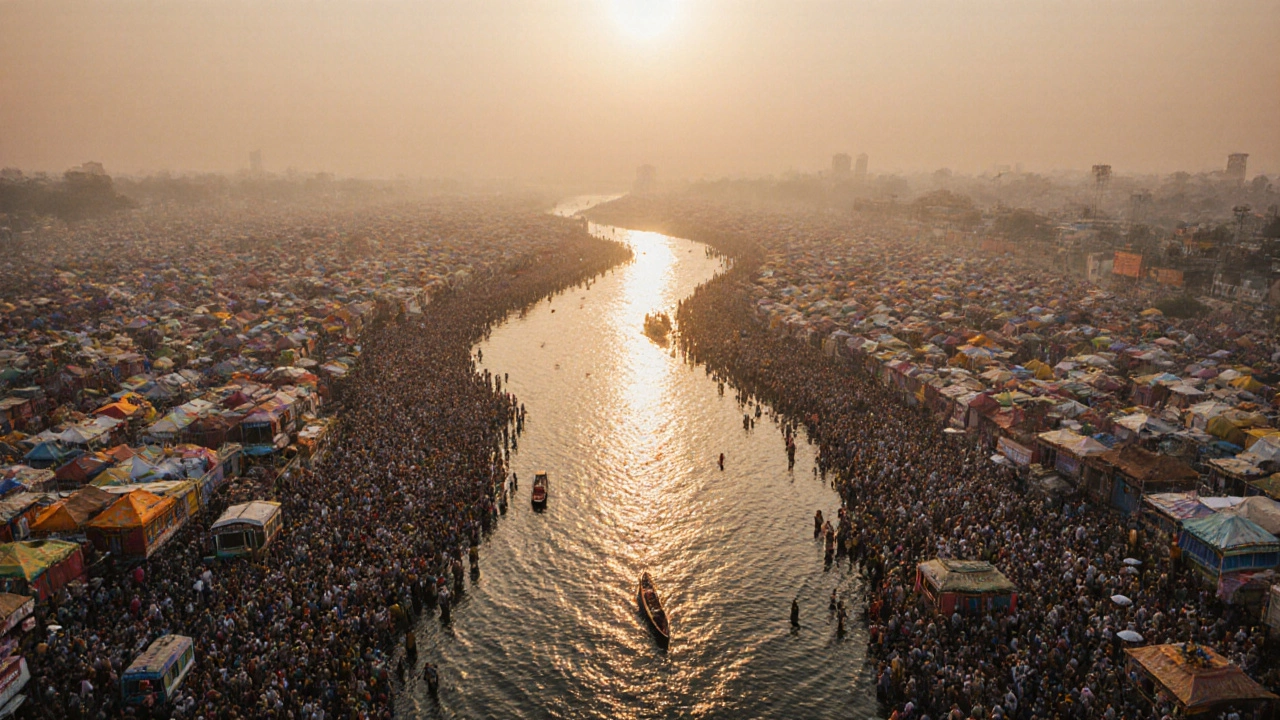Kumbh Mela Festival Planner
Festival Details
Click "Get Details" to view information about the selected Kumbh Mela.
Attendance Statistics
Estimated attendance figures for major Indian religious festivals
When it comes to sheer scale, largest religious festival in India isn’t a debate - it’s the Kumbh Mela, a massive Hindu pilgrimage that transforms four river‑bank towns into bustling spiritual metropolises every few years.
Quick Takeaways
- Kumbh Mela is the world’s biggest religious gathering, drawing up to 120million visitors in a single season.
- The festival rotates among four sacred sites: Prayagraj (Allahabad), Haridwar, Ujjain, and Nashik.
- A full cycle takes 12years; the MahaKumbh Mela at Prayagraj occurs every 144years.
- Key rituals include the sacred dip, the Shahi Snan, and the procession of sadhus.
- Planning early, securing accommodations, and respecting local customs are essential for a safe, rewarding experience.
What Is Kumbh Mela?
Kumbh Mela is a Hindu pilgrimage festival that convenes at the confluence of sacred rivers, where devotees gather to bathe in holy waters and seek spiritual purification. The event is rooted in a mythological battle over a pot of amrita (the nectar of immortality), which was spilled across four locations, making each a site of divine power.
The word "Kumbh" means pot, and "Mela" means fair. Together they symbolize the cosmic pot of life‑giving nectar that was divided among the four rivers: the Ganges, Yamuna, Saraswati (mythical), and the Godavari.
Where and When Does It Happen?
The festival cycles through four cities, each aligned with a specific astronomical configuration:
- Prayagraj (formerly Allahabad) - where the Ganges, Yamuna, and mythical Saraswati meet. Holds the Kumbh when Jupiter is in Leo and the Sun and Moon are in Cancer (every 12years).
- Haridwar - on the banks of the Ganges in Uttarakhand. Hosts the Kumbh when Jupiter is in Aquarius and the Sun and Moon are in Aries.
- Ujjain - on the banks of the Shipra River in Madhya Pradesh. Occurs when Jupiter is in Leo and the Sun and Moon are in Libra.
- Nashik - on the Godavari River in Maharashtra. Takes place when Jupiter is in Leo and the Sun and Moon are in Capricorn.
The next Kumbh Mela is scheduled for Haridwar in 2025, while the monumental MahaKumbh Mela at Prayagraj will not return until 2161.

How Big Is It? Numbers That Wow
Attendance figures are staggering. The 2013 MahaKumbh Mela in Prayagraj recorded an estimated 120million visitors over 55 days, according to the Indian Ministry of Tourism. The 2019 Kumbh at Prayagraj saw about 100million pilgrims, while the 2016 Haridwar Kumbh attracted roughly 80million. These numbers eclipse the crowds of the Hajj pilgrimage, making Kumbh Mela the largest religious gathering on the planet.
Key metrics:
| Festival | Typical Attendance | Frequency | Primary Location |
|---|---|---|---|
| Kumbh Mela (Maha) | ~120million | Every 144years | Prayagraj |
| Kumbh Mela (Regular) | 70‑100million | Every 12years per site | Four rotating sites |
| Durga Puja (Kolkata) | ~10million | Annual | Kolkata |
| Ganesh Chaturthi (Mumbai) | ~5million | Annual | Mumbai |
Rituals & Highlights You Can’t Miss
Every Kumbh Mela is built around a handful of core ceremonies that define the experience:
- Shahi Snan (Royal Bath) - The day when the President of India and other dignitaries take a ceremonial dip, drawing massive crowds.
- Ardh Kumbh (Half Kumbh) - A smaller, yet significant, dip that occurs midway through the festival.
- Processions of Sadhus - Ascetic holy men, many covered in ash, parade through the streets, showing off their spiritual attainments.
- Bhog (Food Offerings) - Massive communal meals served under towering prayer tents, often coordinated by NGOs and local governments.
- Cultural Stages - Classical dance, music, and recitals fill open-air auditoriums, creating a vibrant cultural tapestry.
These rituals are not just spectacles; they embody deep theological concepts about renewal, the cycle of life, and the unity of all beings.
Planning Your Kumbh Mela Journey
Visiting the Kumbh Mela is a life‑changing trip if you prepare right. Here’s a practical checklist:
- Secure Visa Early - Tourist visas for India are straightforward, but processing can take 2‑3 weeks.
- Book Accommodation Months Ahead - Options range from budget hostels to luxury tents. In 2025 Haridwar, demand is expected to fill up by June.
- Plan Transportation - Fly into Delhi (for Prayagraj or Haridwar) or Mumbai (for Nashik). Trains are a cost‑effective way to reach the festival towns.
- Pack Wisely - Lightweight, breathable clothing, a good pair of waterproof sandals, sunscreen, a reusable water bottle, and a small medical kit.
- Stay Healthy - Drink only boiled or bottled water, avoid street food that looks unhygienic, and keep hand sanitizer handy.
- Respect Local Customs - Women should wear modest attire, remove shoes before entering temples, and avoid photographing sadhus without permission.
Most visitors stay in the vicinity for 5‑7 days to experience the peak bathing days, the night‑time aarti (lamp ceremony), and the bustling market lanes.

How Kumbh Mela Stacks Up Against Other Indian Festivals
While Kumbh Mela dominates in size, other festivals offer unique flavors:
- Durga Puja - Celebrated mainly in West Bengal, it showcases elaborate idol art and cultural performances, drawing about 10million people.
- Diwali - The Festival of Lights is observed nationwide with fireworks and home decorations; its commercial impact is huge, but pilgrim numbers are diffuse.
- Ganesh Chaturthi - In Mumbai, massive clay idols are immersed in the sea, pulling crowds of 5‑7million.
- Rath Yatra - The chariot festival in Puri brings up to 10million devotees, but it’s confined to a single city.
In terms of sheer attendance, logistical complexity, and spiritual significance, Kumbh Mela remains unmatched.
Frequently Asked Questions
When is the next Kumbh Mela?
The next scheduled Kumbh Mela is at Haridwar in 2025, with the main bathing days expected in late January and early February.
Which city hosts the largest Kumbh Mela crowd?
Prayagraj (Allahabad) has hosted the biggest crowds, especially during the 2013 MahaKumbh Mela, when attendance peaked at around 120million.
Do I need a special permit to bathe in the river?
No formal permit is required for the ritual dip, but security checks are strict. Follow the crowd‑control directions posted at entry points.
Is the Kumbh Mela safe for solo travelers?
Yes, provided you stay in reputable accommodation, keep valuables secure, and travel in groups for the crowded bathing days. Many solo travelers join guided tours that handle logistics and safety.
What should I wear for the bath?
Simple cotton garments that can get wet are best. Many pilgrims wear white, but any modest, quick‑dry clothing works. Keep a dry change of clothes for after the dip.
Wrapping Up
If you’re chasing an experience that blends spirituality, culture, and sheer human scale, the Kumbh Mela is unbeatable. With careful planning, respect for rituals, and a willingness to get a little wet, you’ll walk away with memories that outlive any postcard.
